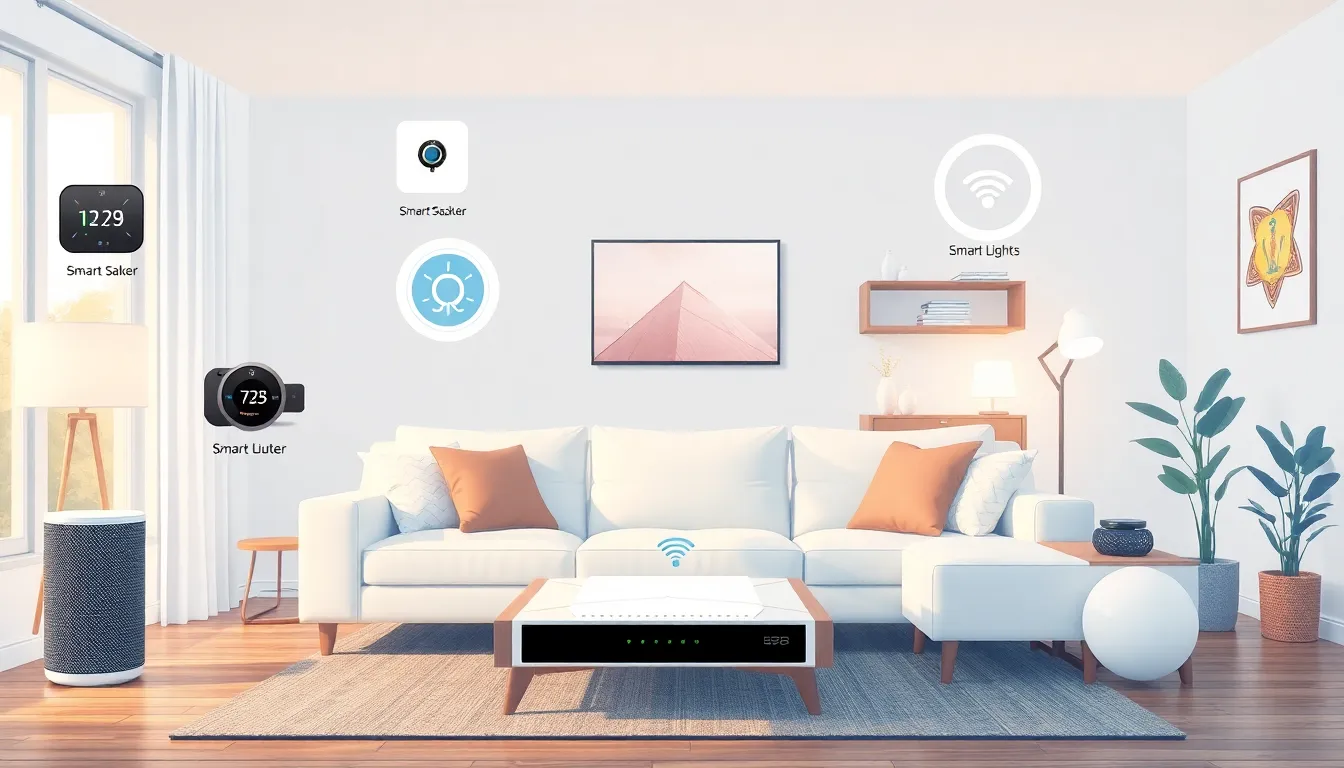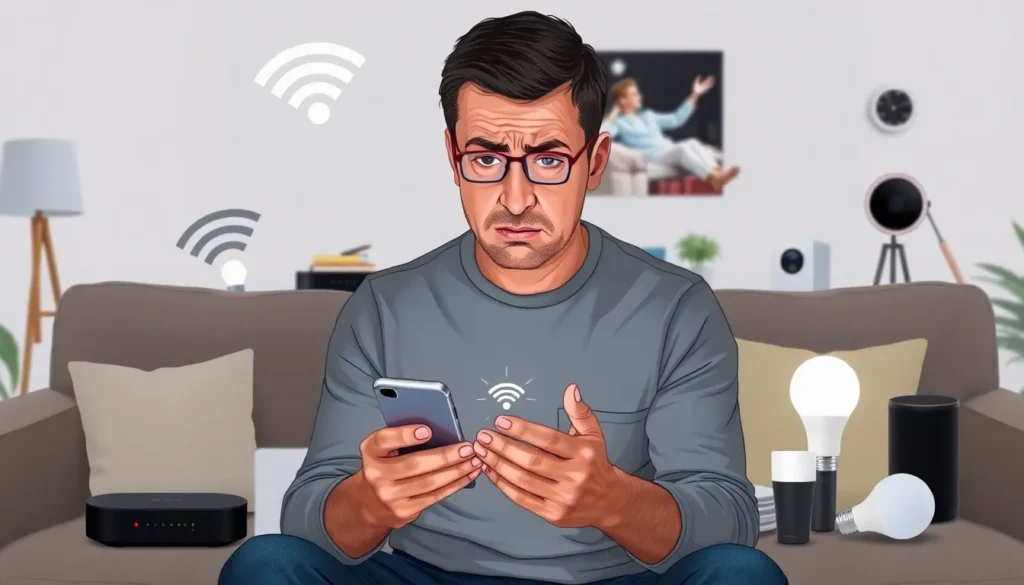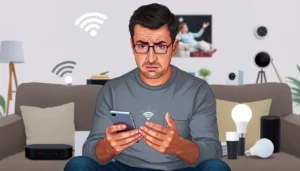Table of Contents
ToggleIn the quest for a smarter home, many have jumped on the tech bandwagon, dreaming of a life where everything runs like clockwork. But hold on to your smart light bulbs! With great power comes great responsibility—and a few hiccups along the way. From Wi-Fi woes to compatibility conundrums, navigating the smart home landscape can feel like trying to teach a cat to fetch. Spoiler alert: it’s not easy.
As homeowners embrace the convenience of automation, they often find themselves wrestling with unexpected challenges. Whether it’s a voice assistant that misunderstands commands or security systems that seem to have a mind of their own, the road to a fully connected home isn’t always smooth. Get ready to chuckle at the quirks of smart living while uncovering the hurdles that come with turning a house into a high-tech haven.
Overview of Smart Home Challenges
Smart home technology brings convenience but presents challenges for users. Wi-Fi connectivity issues often top the list, disrupting device communication. Many homeowners find that weak signals or network outages create significant frustration. Compatibility problems further complicate the issue, as not all devices work seamlessly together. Various brands and protocols can lead to devices refusing to cooperate, limiting the potential for a fully integrated system.
Voice assistants also create difficulties, showing a tendency for miscommunication. Misunderstandings between the user and the assistant can result in wrong commands or actions. Voice recognition may not easily accommodate different accents, leading to user dissatisfaction. Regular software updates can introduce bugs that impact functionality, adding to the challenges faced by homeowners.
Security concerns play a critical role in the conversation about smart homes. Cybersecurity threats pose risks as more devices connect to the internet, making homeowners apprehensive about data privacy. Weak passwords or unencrypted connections can leave networks vulnerable, exposing sensitive information.
Installation issues arise based on layout and existing infrastructure, leading to uneven coverage and performance. Heavily cluttered spaces may obstruct signals, while older homes might lack the wiring needed for smart technology. DIY installations can quickly turn into daunting tasks without proper knowledge.
Overall, navigating the smart home landscape involves balancing convenience and technical obstacles. Homeowners continue to embrace the technology despite these hurdles, always seeking solutions to enhance their smart home experiences.
Common Technical Issues

Smart home systems often face technical challenges that hinder optimal functionality. Homeowners encounter various issues, from connectivity to compatibility.
Connectivity Problems
Connectivity problems play a significant role in smart home frustrations. Devices often rely on stable Wi-Fi networks for seamless integration. Weak signals lead to inconsistent performance, and network outages completely disrupt communication. In multi-story homes, distance from the router can weaken signals further. Furthermore, interference from other electronic devices may impact performance. Solutions include Wi-Fi extenders or mesh networks designed to enhance coverage throughout the home. Prioritizing a strong network infrastructure significantly improves device reliability.
Compatibility Issues
Compatibility issues also challenge smart home users. Not all devices work harmoniously together, especially when using different brands or protocols. This situation complicates the integration process, often leaving homeowners with limited choices. Smart hubs can help unify devices, but still, not every product supports every protocol. Identifying compatible devices before making purchases prevents future headaches. Regularly checking for software updates can enhance functionality, allowing devices to communicate better. Investing in well-reviewed products with proven compatibility simplifies the smart home experience.
Security Concerns
Smart home technology introduces significant security challenges. Users must navigate data privacy risks and vulnerability to hacking as they automate their living spaces.
Data Privacy Risks
Smart devices constantly collect user data, often without explicit consent. Major concerns arise from the potential for unauthorized access to personal information. Sensitive data shared with devices, such as health information and daily habits, can end up exposed if proper safeguards aren’t in place. Companies frequently utilize data for marketing purposes, raising questions about transparency. Homeowners face responsibilities related to managing privacy settings. Regularly reviewing these settings helps mitigate exposure risks.
Vulnerability to Hacking
Connected devices can create entry points for cybercriminals. Hackers exploit weak security measures, such as default passwords, to gain control over smart home systems. Insecure networks increase the likelihood of breaches. Regular software updates help secure devices against known vulnerabilities. Enabling two-factor authentication adds an extra layer of protection. Homeowners should remain vigilant and monitor device activity for unusual behavior. Investing in reputable brands with established security protocols provides further protection against hacking threats.
User Experience Challenges
Homeowners face various user experience challenges when integrating smart home technology. Common issues arise during setup, compatibility, and device management.
Complexity of Setup
Setting up smart home devices often proves complicated. Steps can include connecting devices to networks and configuring settings for optimal performance. Many users encounter difficulties with installation, especially if they lack technical expertise. Different manufacturers provide inconsistent instructions, leading to confusion about the process. As a result, homeowners may spend excessive time troubleshooting or even abandon their devices altogether. Simplified setup processes and better user guides can alleviate these issues. Many consumers appreciate streamlined apps that guide them through the setup phase without overwhelming details.
Lack of Standardization
The lack of standardization across smart home devices complicates user experience. Different brands utilize various communication protocols, making integration difficult. A homeowner may purchase devices from multiple manufacturers, only to discover they don’t seamlessly connect. Disparate systems detract from the overall convenience of smart technology. Many consumers prefer devices that adhere to universal standards, allowing for smoother interoperability. Developing common protocols would enhance device compatibility and foster a more cohesive smart home ecosystem. Consistent regulatory frameworks might also encourage manufacturers to align their technologies, ultimately benefiting users.
Navigating the world of smart home technology can be a rollercoaster of challenges and unexpected hurdles. Homeowners are learning to balance the allure of convenience with the complexities of integration and security. While issues like Wi-Fi connectivity and device compatibility can be frustrating they also present opportunities for innovation.
By staying informed about the latest solutions and best practices homeowners can create a smarter and more secure living environment. Embracing these challenges ultimately leads to a more fulfilling smart home experience. With ongoing advancements in technology the future looks promising for those willing to adapt and overcome the obstacles in their path.







